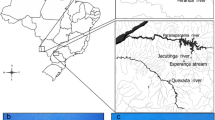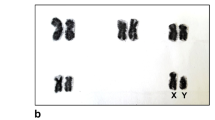Abstract
A cytogenetic study performed on a population of the South American leptodactylid frog Eleutherodactylus maussi revealed multiple sex chromosomes of the X1X1X2X2♀/X1X2Y♂ (=XXAA♀/XXAY♂) type. The diploid chromosome number is 2n=36 in all females and 2n=35 in most males. The multiple sex chromosomes originated by a centric fusion between the original Y chromosome and a large autosome. In male meiosis the X1X2Y (=XXAY) multiple sex chromosomes form a classical trivalent configuration. E. maussi is the first species discovered in the class Amphibia that is distinguished by a system of multiple sex chromosomes. Only one single male was found in the population with 2n=36 chromosomes and lacking the Y-autosomal fusion. This karyotype (XYAA♂) is interpreted as the ancestral condition, preceding the occurrence of the Y-autosome fusion.
Similar content being viewed by others
References
Bogart JP (1970) Systematic problems in the amphibian family Leptodactylidae (Anura) as indicated by karyotypic analysis. Cytogenet Cell Genet 9:369–383
Bogart JP (1973) Evolution of anuran karyotypes. In: Vial JL (ed) Evolutionary biology of the anurans. University of Missouri Press, Columbia, pp 337–349
Bogart JP (1981) Chromosome studies in Sminthillus from Cuba and Eleutherodactylus from Cuba and Puerto Rico (Anura: Leptodactylidae). Life Sci Contrib 129:1–22
Bull JJ (1983) Evolution of sex determining mechanisms. Benjamin/Cumming, Menlo Park, California
Duellman WE, Trueb L (1986) Biology of the amphibians. McGraw-Hill, New York
Frost DR (1985) Amphibian species of the world. Allen Press, Lawrence, Kansas
Hillis DM, Green DM (1990) Evolutionary changes of heterogametic sex in the phylogenetic history of amphibians. J Evol Biol 3:49–64
King M (1990) Amphibia. In: John B (ed) Animal cytogenetics, vol 4/2. Gebrüder Borntraeger, Berlin Stuttgart
Lynch JD (1971) Evolutionary relationships, osteology, and zoogeography of leptodactyloid frogs. Misc Publ Mus Nat Hist Univ Kansas 53:1–238
Ohno S (1967) Sex chromosomes and sex-linked genes. Springer, Berlin Heidelberg New York
Saitoh K (1989) Multiple sex-chromosome system in a loach fish. Cytogenet Cell Genet 52:62–64
Schmid M (1978) Chromosome banding in Amphibia. I. Constitutive heterochromatin and nucleolus organizer regions in Bufo and Hyla. Chromosoma 66:361–388
Schmid M (1980) Chromosome banding in Amphibia. IV. Differentiation of GC- and AT-rich chromosome regions in Anura. Chromosoma 77:83–103
Schmid M (1983) Evolution of sex chromosomes and heterogametic systems in Amphibia. Differentiation 23:S13-S22
Schmid M, Haaf T (1989) Origin and evolution of sex chromosomes in Amphibia: the cytogenetic data. In: Wachtel SS (ed) Evolutionary mechanisms in sex determinaton. CRC Press, Boca Raton, Florida, pp 37–56
Schmid M, Olert J, Klett C (1979) Chromosome banding in Amphibia. III. Sex chromosomes in Triturus. Chromosoma 71:29–55
Schmid M, Haaf T, Geile B, Sims S (1983) Chromosome banding in Amphibia. VIII. An unusual XY/XX sex chromosome system in Gastrotheca riobambae (Anura, Hylidae). Chromosoma 88:69–82
Schmid M, Nanda I, Steinlein C, Kausch K, Haaf T, Epplen JT (1991) Sex determining mechanisms and sex chromosomes in Amphibia. In: Green DM, Sessions SK (eds) Amphibian cytogenetics and evolution. Academic Press, New York (in press)
Schweizer D (1976) Reverse fluorescent chromosome banding with chromomycin and DAPI. Chromosoma 58:307–324
Vorontsov NN (1973) The evolution of the sex chromosomes. In: Chiarelli AB, Capanna E (eds) Cytotaxonomy and vertebrate evolution. Academic Press, London New York
White MJD (1973) Animal cytology and evolution. Cambridge University Press, London New York
Wilson AC, Sarich VM, Maxson LR (1974) The importance of gene rearrangements in evolution: evidence from studies on rates of chromosomal, protein, and anatomical evolution. Proc Natl Acad Sci USA 71:3028–3030
Author information
Authors and Affiliations
Additional information
by H.C. Macgregor
Rights and permissions
About this article
Cite this article
Schmid, M., Steinlein, C. & Feichtinger, W. Chromosome banding in amphibia. Chromosoma 101, 284–292 (1992). https://doi.org/10.1007/BF00346007
Received:
Accepted:
Issue Date:
DOI: https://doi.org/10.1007/BF00346007




